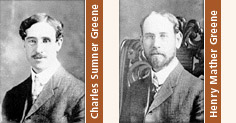|

|
Charles Sumner Greene was born October 12, 1868 to Lelia Ariana
and Thomas Sumner Greene in Cincinnati, Ohio. Fifteen months
later, on January 23, 1870, Henry Mather Greene was born. The
family later moved to St. Louis where, as teenagers, Charles
and Henry attended Calvin Woodward’s Manual Training School
of Washington University, which offered a revolutionary curriculum
based on |
the education of
the hand as well as the mind. This early training was the
primary source of the brothers’ focus on tools, materials,
and craftsmanship. In 1888 the brothers enrolled in the architectural
program at the Massachusetts Institute of Technology in Boston.
In 1891 both brothers completed their studies with Certificates
of Partial Course, the two-year program followed by most MIT
architecture students. They then apprenticed with several
of the finest architectural firms in Boston, including those
whose principals had been associates of the noted Henry Hobson
Richardson.
In 1893 the Greene brothers traveled west to
Pasadena to visit their parents, who had moved from St. Louis
the previous year and in the fall of 1894, they opened their
architectural practice.
Henry Mather Greene married Emeline Augusta
Dart in 1899, and in a few years, Charles wed Alice Gordon
White. Charles and Alice’s four-month honeymoon in England,
Scotland and Europe sparked Charles’ interest in the
English Arts and Crafts Movement.
Activity in the Greene & Greene office was
at its peak during the years 1902-1910, with primary focus
on residential design. It was during this period that they
created some of their finest work. By 1903, Greene & Greene
began to offer integrated design services for their clients,
providing design and construction supervision of furniture
and other interior appointments. They completed approximately
150 projects during these prolific years.
After 1911 the practice began to decline because
Greene & Greene designs demanded higher fees and clients
experienced frequent schedule overruns. The situation became
unacceptable to most clients and by 1916, the brothers personal
interests diverged. Charles moved to Carmel to pursue other
creative paths, while Henry continued the firm's work in Pasadena
until the dissolution of the firm in 1922. Henry practiced
independently after the separation and Charles, too, worked
on occasional commissions during the 1940’s, most being
additions and renovations for former clients.
The death of Henry’s wife in 1935 affected
him so deeply, that he eventually moved to the home of his
son and daughter-in-law, where he continued to work on small
projects, reuniting with Charles briefly on a commission.
Charles managed to remain much more active in architecture
during the Depression of the 1930s, but his interests soon
shifted to passionate study of Eastern philosophy, spiritualism
and creative writing. Henry passed on October 2, 1954, in
Pasadena, California and Charles died on June 11, 1957 in
Carmel-by-the-Sea, California.
|
Charles and Henry Greene are widely considered to have brought
high-art aesthetics and exquisite craftsmanship to the American
Arts and Crafts Movement in the early part of the 20th century.
Their work continues to be exhibited worldwide and is included
in decorative arts collections in museums in the United States
and throughout Europe. Greene & Greene designs strongly
influenced California’s architectural heritage, their
work has had international significance as well, inspiring
countless architects and designers around the world through
a legacy of extant structures, scholarly books and articles.
They were recognized by the American Institute of Architects
in 1952 for contributing to a "new and native architecture"
and are generally credited with fostering a new way of considering
buildings and their furnishings as examples of artistic craft.
Popular architecture and design magazines such as The
Craftsman, House Beautiful, The International Studio, Country
Life in America, House and Garden, Good Housekeeping,
and American Home and Garden began featuring articles
on Greene & Greene work in 1902, this acclaim helped spread
the their designs throughout the country. The rediscovery
of their work by the architectural press in the 1950s created
a new group of admirers who celebrated their distinctly American
interpretation of the Arts and Crafts style as an antidote
to the International style, which had gained popularity in
Europe and elsewhere.
Today, the current generation of Greene & Greene aficionados
tour the Greene & Greene residencies and other buildings
in California with reverence, like pilgrims paying homage
to honored monuments. The Gamble House, one of their masterpieces,
receives 30,000 visitors a year from all over the world. Recently
available public tours of the Thorsen and Blacker houses drew
thousands of visitors and raised awareness of both Greene
& Greene residential architecture and furniture design.
Interior, architectural design, and architectural history
journals such as Style 1900 and American Bungalow
are now full of vendors offering reproductions of their furniture
and décor.
|